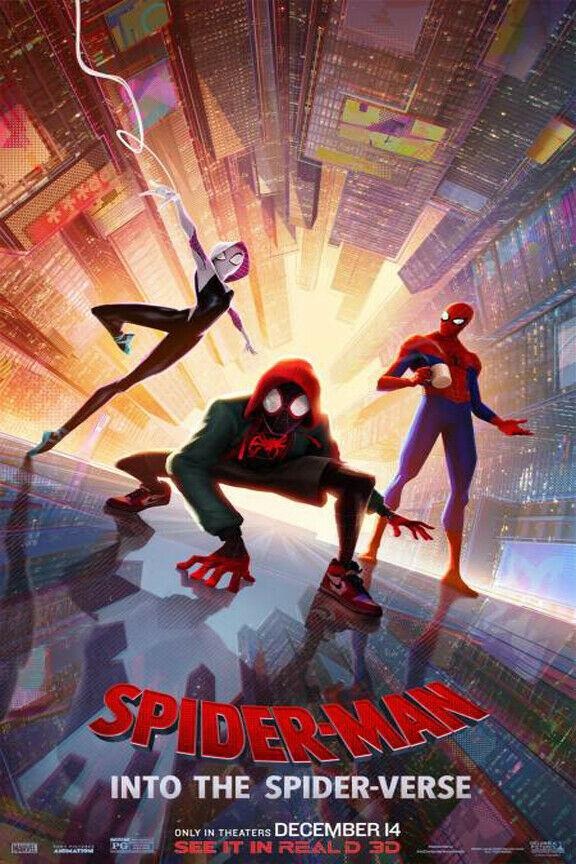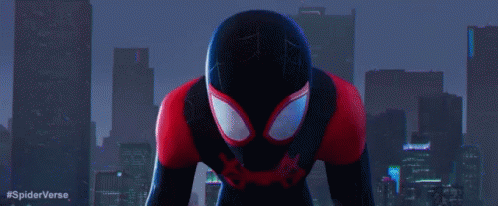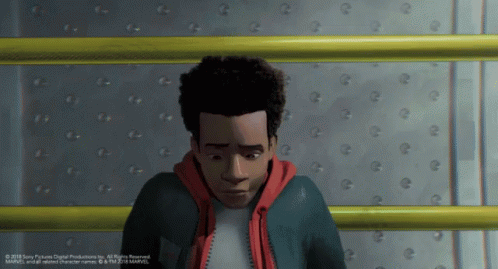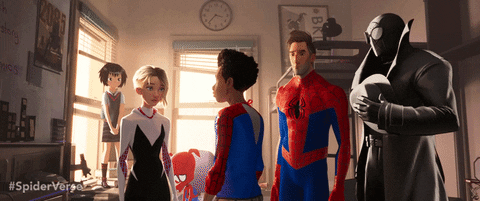"You Can Wear the Mask:" Taking a Leap of Faith When Scared and Representation in Spider-Man: Into the Spider-Verse

Spider-Man: Into the Spider-Verse, directed by Bob Persichetti, Peter Ramsey, and Rodney Rothman, is an animated film that was released on December 14, 2018. Although it is far from the first Spider-Man film, it is one of the first animated Spider-Man films. It is also one of the few Spider-Man films to win an academy award (it won Best Animated Feature at the 91st Academy awards). It follows Miles Morales as he struggles to come to terms with being Spider-Man, while trying to save the world. While trying to save the world, Miles must figure out how to get his other Spider-Men/Women/Ham back to their worlds before it’s too late. I, personally, can talk about this movie forever since it is one of my absolute favorites. This movie was also the reason why I decided to create these animation articles, because I see it as the best Spider-Man film of all time. Yet, it did poorly in the box office because it was an animated film and people assumed it was for children. Before I go on a rant about that, I want to talk about what this movie taught its audience about going forward and how well it portrayed representation throughout the film.

Let me start by talking about the main character of the film and how representation is shown through him. Miles Morales, an Afro-Latino teenager, does not expect to become Spider-Man at the beginning of the movie. He thinks that he only must worry about surviving at this rich, private school, when all he wants to do is go to school in his neighborhood. Miles is very hesitant about going to this new school because he finds it “elitist” and he wants to go to a school “among the people” (Persichetti, Ramsey, Rothman). However, his father, Officer Jefferson Davis, wants Miles to go to this school because it’s a great opportunity for Miles and pushes Miles to be even greater. As Miles heads off to school, the audience gets to see what his home life is like and what his neighborhood is like. The audience sees Miles speaking Spanish to his mother and friends from the neighborhood, while interacting with all kinds of kids from his old school. The audience gets to see a normal Brooklyn neighborhood that is shown in a positive light. They also get to see a main character speaking fluent Spanish, without the need for subtitles. This is only ten minutes into the film and the audience gets to witness all kinds of representation. Especially since this kind of representation is not always shown or portrayed like this in other forms of media. This representation means so much for biracial kids/teens/adults. This kind of neighborhood and household is not always shown in a positive light, or even at all in any form of media. Yet, to see a future Spider-Man come from the same place as them, makes the difference. Especially for these biracial kids. For these kids, “this Afro-Latino boy who would become Spider-Man was a sign of our times, a reminder of the past, and a means of hope for the future” (Newby).

Moving on from representation for now, I’m going to start talking about Miles’ character development. When Miles is bitten by a radioactive spider, he finds out he has Spider-Man powers. Which causes him to react like any normal teen and precedes to freak out. At first, Miles attempts to call his Uncle Aaron. Uncle Aaron was with him when he got bit and thought that he could help Miles. However, Uncle Aaron is out of town for some business, so Miles is on his own. Miles goes back to where he was bitten by the spider, only to get caught up in a fight between his world’s Spider-Man and Green Goblin. Spider-Man saves Miles at one point, where they discover that they are the same. Spider-Man promises to teach Miles how to be Spider-Man after he destroys this Super-Collider that could destroy the entire city. However, it doesn’t end well for Spider-Man, who gets shoved into the collider and caught up in a big explosion. Miles can talk to Spider-Man one last time and he is entrusted with a way to stop the Collider. Spider-Man tells Miles to run as villains start to approach Spider-Man. Miles can hide before Kingpin, the villain who activated the Collider, kills Spider-Man. Miles runs away in fear and tries to come to terms with his new powers. After Spider-Man’s death, his identity as Peter Parker is revealed to the world. Miles, who goes to the wake, comes to the realization that it is all up to him to save his city. So, he attempts to swing around the city like Spider-Man but fails and ends up destroying the only thing that could stop the collider. This point of the film shows that Miles is a novice that is severely lacking self confidence in himself.
So, Miles, lost and confused, goes to visit the grave of Peter Parker. This is where he meets another Spider-Man (Peter B. Parker) from another dimension. Mile’s able to get Peter to agree to train him as they try to retrieve the data that could stop the collider. Now that Miles has a teacher, he feels a little more confidence in himself. However, he still has a long way to go before he can call himself Spider-Man. As Miles and Peter run away from the lab, they stole the data from, they meet Gwen Stacey. Before talking more about Miles’ development, I’m going to talk about Gwen Stacey. She is a ballerina Spider-Woman from an alternate dimension, and she is displayed as a cool, strong character with great development. This is also the first time that fans of Spider-Man got to see a Spider-Women on the big screen. It’s another form of representation that little kids, especially little girls, need to see. Gwen is the one that saves Peter and Miles at the lab, which shows how worthy of a Spider-Women she is. As the movie progresses, Gwen takes them to the only person that could help the three of them, May Parker.

May Parker takes the three of them to the dead Peter Parker’s hideout, where they meet three other Spider people. Peter Parker from a universe where it’s 1933, he’s a private eye Spider-Man, who fights Nazis. Peni Parker, a young Asian girl from a universe where it is 3145, and she controls a Spider-Man mecha robot named SP//dr. Peter Porker, a Spider-Pig called Spider-Ham, who was a spider that was bitten by a radioactive pig. There’s a lot of first time seen on the big screen in this group, but the fact that there is another Spider-Woman, one of Asian descent is a big deal. This movie shows a lot of firsts, especially since the first ever Spider-Man was a white man, so these characters inspire a whole new generation of Spider-Man fans. The movie has more representation in it than most of the Spider-Man films. Half of the main characters represent a group of people that rarely get to see themselves on the big screen and they’re all heroes. Future generations will look back on this film and see themselves through these characters and think they can be heroes. Representation in this film is done exceptionally well and is a prime example on why it matters.

Alright, so now let’s get back to Mile’s development. After meeting the other Spider people, Miles proclaims that he will save the day and get all of them home. However, this group unintentionally makes Miles feel inadequate to be Spider-Man. Miles has only been Spider-Man for a day, so seeing all these other Spider people makes himself conscious. There is this one frame when Miles is in dead Peter’s hideout right before meeting the others, where he is looking up at a Spider-Man costume. The glass reflects Miles’ appearance, and it shows Miles’ head at Spider-Man’s chest. This symbolizes that Miles was not ready to be Spider-Man at that moment. So, after getting a beat down from all the other Spider people, who were testing him to see if he was qualified to be Spider-Man, he leaves and heads off to his Uncle Aaron’s place. Miles knows he’s not ready yet and he’s scared, so he runs away.

Unfortunately for Miles, once he’s at Uncle Aaron’s, Miles finds out what Aaron has been doing all this time. It turned out Uncle Aaron was the super villain, the Prowler. He was the villain that was working for Kingpin and would chase Miles down. Instead of facing his uncle, Miles runs back to where the rest of the Spider people are. Miles, running away from his uncle, unintentionally leads all the villains to Aunt May’s house. This causes a standoff with all the villains, and Miles ends up facing his uncle. His uncle almost kills Miles but stops when Miles reveals who he was. Uncle Aaron’s hesitation to kill Miles ends up with him being killed by Kingpin. This tragedy pushes Miles to anger and frustration, making him want to take Kingpin down even more. Although his intentions are good, Miles’ motivation is wrong. Eventually, Peter B. Parker and the rest of the Spider people tell Miles he has to sit this out. They try not to be harsh about it, but they say he is not ready to be Spider-Man yet. Even after hearing that, Miles still attempts to go with them. This forces Peter to tie Miles up to a chair to keep him from following.
Miles, clearly exasperated, asks Peter, when will he know that he’s ready to be Spider-Man. Peter, before leaving Miles behind, says “you won’t. That’s all it is, Miles, a leap of faith” (Persichetti, Ramsey, Rothman). As Miles is forced to sit there and think about what Peter said, Mile’s dad comes to the door. Through the door, he talks to Miles, trying to tell him about his uncle’s death. When Miles doesn’t respond, Jefferson believes that Miles is mad at him for pushing him. So, he tells Miles that the reason he pushes Miles so hard is because of how much he believes in him and the potential he has. After his dad leaves, Miles can break out of the webs, finally gaining the confidence in his powers and being able to summon them whenever he wants. Mile has grown confidence which gave him control. With his new control over his abilities, he heads to Aunt May’s.

Mile’s is ready to face his fears of being Spider-Man, which leads to this beautiful, bad-ass scene. In this scene, Miles stands in front of the Spider-Man suit, and this time. The glass reflects Miles’ head where the mask is. This symbolizes that Miles is finally ready to be Spider-Man. However, the audience can tell that Miles is still very scared to be Spider-Man. When Miles leaps off the building, the glass that his fingers were on breaks as he jumps off. This shows that Miles was still scared to let go. This is Miles’ leap of faith, which shows that even though he is still very scared, he’s ready to be Spider-Man. This is when Miles knew that he could save his city, his new friends, and put an end to Kingpin. Miles has changed so much from the once timid and scared Spider-Man. He pushed past his fears and moved forward to save his city and his friends.
In the end, Miles can send all his friends back to their universes, destroy the collider, and stop Kingpin. Even though Miles was scared throughout the whole fight with Kingpin, he kept getting back up. As it was stated throughout the movie, Spider-Man is always able to get back up and fight. This finalized the belief that Miles was ready. The movie ends with Miles talking to the audience of the film. Miles tells them that anyone can be Spider-Man, that anyone can wear the mask. Which is inspiring for the new generation of Spider-Man fans. This line ingrains in their minds that no matter what they look like or who they are, they have what it takes. Which is the biggest reason why I love this movie because it inspires others to be their best and keep trying. Everyone has what it takes to be a hero. “That “leap of faith” philosophy, along with the “anyone can wear the mask” thesis at the heart of the film, is a perfect encapsulation of why we love Spider-Man, and why audiences fell in love with Miles Morales” (Jackson). Miles encapsulated an everyday kid at the beginning of the film. At the end, with a little push, he was able to develop into so much more. He became a hero. He pushed forward into the unknown and didn’t back down.
This movie is a beautiful film, with mind blowing animation, amazing characterization, and a solid story line. It didn’t shy away from representation, it embraced it. It teaches one to keep fighting, to keep getting back up. It tells the audience that they can save the world, but they don’t always have to do it alone. It’s worth the watch if you haven’t already. Now, I will leave you with this quote:
The film Spider-Man: Into the Spider-Verse helps us to learn the importance of relying on people and fighting through life’s adversity to save ourselves and the world.
Work Cited
Jackson, Matthew. “How Into the Spider-Verse Perfectly Captures What It Means to Be Spider-Man.” SYFY WIRE, SYFY WIRE, 10 Jan. 2019.
Martyn, Nikki. “What ‘Into the Spider-Verse’ Can Teach Us about Resilience.” The Conversation, 18 Dec. 2019.
Newby, Richard. “’Into the Spider-Verse’ and the Importance of a Biracial Spider-Man.” The Hollywood Reporter, 11 Dec. 2019.
Persichetti, Bob, et al., directors. Spider-Man: Into the Spider-Verse . Sony Pictures Animation , 2018.
0 Comments Add a Comment?